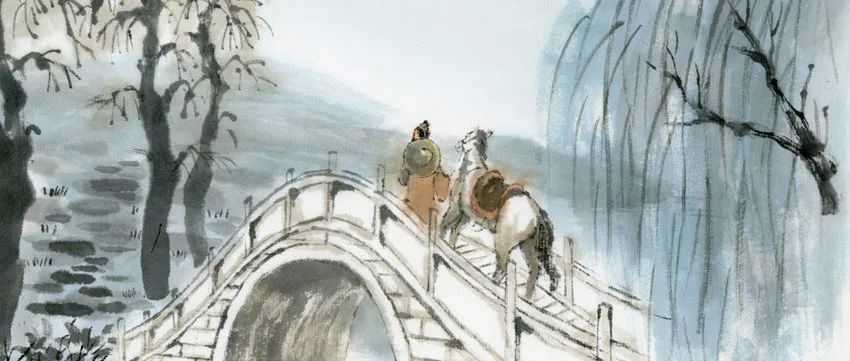Slow Tune of Yangzhou
- Poetry of Jiang Kui

淳熙丙申至日,予过维扬。夜雪初霁,荠麦弥望。入其城,则四顾萧条,寒水自碧,暮色渐起,戍角悲吟。予怀怆然,感慨今昔,因自度此曲。千岩老人以为有“黍离”之悲也。
淮左名都,竹西佳处,解鞍少驻初程。
过春风十里。尽荠麦青青。
自胡马窥江去后,废池乔木,犹厌言兵。
渐黄昏,清角吹寒。都在空城。
杜郎俊赏,算而今、重到须惊。
纵豆蔻词工,青楼梦好,难赋深情。
二十四桥仍在,波心荡、冷月无声。
念桥边红药,年年知为谁生。
On Winter Solstice in 1127,I passed Yangzhou.It turned fine after one night of snow.I saw the fieldsovergrown with wild wheat and weeds.When I entered the ruined town,I looked around and was grieved to see green water cold and to hear sad horns blow at dusk.I felt sad and dreary to compare the present desolation with the past glory and composed the following tune which reveals the grief of a ruined country,as says my old uncle-in-law.
In the famous town east of River Huai
And scenic spot of Bamboo West,
Breaking my journey,I alight for a short rest.
In breeze the splendid three-mile road did I pass by.
'Tis now o'ergrown with wild green wheat and weeds.
Since Southern shore was overrun by Jurchen steeds,
E'en the tall trees beside the pond have been war-torn.
As dusk is drawing near,
Cold blows the horn,
The empty town looks drear.
The place Du Mu the poet prized,
If he could come again today,
Would make him feel surprised.
His verse on the cardamon spray
And on sweet dreams in Mansions Green
Could not express
My deep distress.
The Twenty-four Bridges can still be seen,
But the cold moon floating among
The waves would no more sing a song.
For whom should the peonies near
The Bridges grow red from year to year?
Jiang Kui (1155?-1221?)was the first musician among the lyrical poets of the Southern Song Dynasty.This lyric was written when he passed by Yangzhou,most prosperous city before Jurchen invasion,situated to the east of the River Huai and well known for scenic spots such as the Pavilion of West Bamboo and Twenty-four Bridges.
- Why Chinese poems is so special?
- The most distinctive features of Chinese poetry are: concision- many poems are only four lines, and few are much longer than eight; ambiguity- number, tense and parts of speech are often undetermined, creating particularly rich interpretative possibilities; and structure- most poems follow quite strict formal patterns which have beauty in themselves as well as highlighting meaningful contrasts.
- How to read a Chinese poem?
- Like an English poem, but more so. Everything is there for a reason, so try to find that reason. Think about all the possible connotations, and be aware of the different possibilities of number and tense. Look for contrasts: within lines, between the lines of each couplet and between successive couplets. Above all, don't worry about what the poet meant- find your meaning.
List of Chinese poets
Pre-Qin Poetry
Han poetry
Ban Gu Cao Cao Cao Zhi Cao Pi Cai Wenji Kong Rong Liu Bang Liu Che Qin Jia Ruan Ji Su Wu Wang Can Xiang Yu Xu Gan Zhang Heng AnonymousSix Dynasties Poetry
Tao Yuanming Zhang HuaTang poetry
Bai Juyi Bao Junhui Cen Shen Chen Zi'ang Cui Hao Chang Jian Cui Tu Chen Tao Du Fu Du Mu Du Shenyan Dai Shulun Du Xunhe Du Qiuniang Gao Shi Gu Kuang Gao Pian Han Yu He Zhizhang Han Hong Huangfu Ran Han Wo Huang Chao Jia Dao Jiaoran Jin Changzu Li Bai (Li Po) Li He Li Shangyin Liu Yuxi Liu Zongyuan Luo Binwang Li Qi Liu Changqing Lu Lun Li Shen Li Yu Li Qiao Li Yi Liu Fangping Liu Zhongyong Li Ye Meng Haoran Meng Jiao Ma Dai Pei Di Qian Qi Quan Deyu Sikong Shu Song Zhiwen Shen Quanqi Shangguan Wan'er Xuanzong of Tang Wang Bo Wang Changling Wang Wei Wang Zhihuan Wei Yingwu Wen Tingyun Wang Han Wei Zhuang Wang Wan Xue Tao Xu Hun Xu Hui Yuan Zhen Yu Xuanji Yu Shinan Yuan Jie Zhang Jiuling Zhang Ji Zhang Hu Zhang Zhihe Zu Yong Zhang Xu Zhu Qingyu Zheng Tian Zhang Bi Zhang RuoxuSong Poetry
Cai Xiang Chao Chongzhi Fan Chengda Fan Zhongyan Huang Tingjian He Zhu Kou Zhun Jiang Kui Lu You Li Qingzhao Liu Yong Mei Yaochen Ouyang Xiu Pan Lang Qin Guan Qian Weiyan Su Shi Su Zhe Song Qi Wang Anshi Wen Tianxiang Weng Juan Xin Qiji Yang Wanli Yue Fei Yan Jidao Yan Shu Ye Shaoweng Zeng Gong Zhang Xian Zhou Bangyan Zhu Shuzhen Zhu Xi Zhou DunyiYuan poetry
Bai Pu Guan Hanqing Ma Zhiyuan Xu Zaisi Yang WeizhenMing poetry
Chen Jiru Tang Yin Tang Xianzu Xu Wei Yu Qian Yang ShenQing poetry
Cao Xueqin He Shuangqing Nalan Xingde Pu Songling Tsangyang Gyatso Wang Guowei Yuan Mei Zheng Xie Zhao Yi